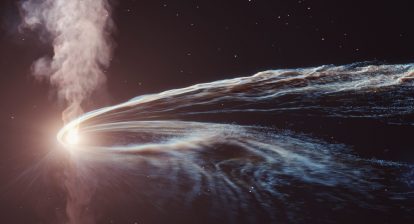Like a majority of galaxies, there is a supermassive black hole called Sag A*, at the centre of our home galaxy, the Milky Way (What is a black hole?).This black hole is equal to about four million suns, but this mass is compacted inside a small space and that’s why the gravity is so high. A variety of stars orbit Sag A*, and it is due to there orbits that we are able to infer Sag A*’s presence because otherwise black holes are so dense that even light cannot escape them, making them impossible to see.
Scientists have been trying to image this galactic centre and now a new video zooms into the centre of the galaxy to take a much closer look. The video starts with a broad view of the Milky Way and then dives in towards the black hole. A swarm of stars can be seen orbiting an invisible object.
As we get closer to it, we see these stars, as observed by the NACO instrument on ESO’s Very Large Telescope (the last observation being from 2019). As we zoom in further, we see stars even closer to the black hole, observed with the GRAVITY instrument on ESO’s Very Large Telescope Interferometry in mid-2021.
Star S300 has never been seen before and star S29 is seen whipping around it at great speeds (8,740km per second) just 13 blllion km away from Sag A*. These latest observations, confirm that the stars follow paths exactly as predicted by General Relativity for objects moving around a black hole of mass 4.3 million times that of the Sun.
This is the most precise estimate of the Milky Way’s central black hole mass to date, with a precision of about 0.25%.

Stars moving around the black hole: these images were taken between March and July 2021 and show stars orbiting very close to Sagittarius A*. During the observations, one of these stars, S29, reached its closest approach to this supermassive black hole at the heart of the Milky Way; the distance was 13 billion kilometres, which is just 90 times the distance between the Sun and Earth. In addition, the researchers discovered another star, S300, with the Gravity Instrument at the European Southern Observatory’s Very Large Telescope Interferometer (VLTI). © ESO / GRAVITY Collaboration
Credit: ESO/GRAVITY collaboration/L. Calçada, N. Risinger (skysurvey.org), DSS. Music: Johan Monel






